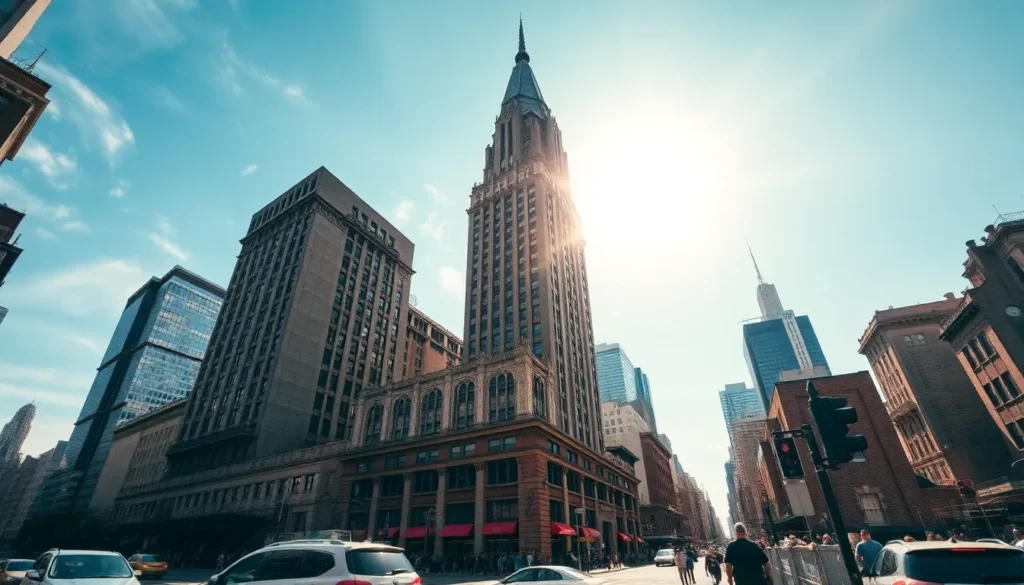Table of Contents
ToggleThe Chrysler Building isn’t just a skyscraper; it’s a dazzling work of art that towers over Manhattan like a crown jewel. With its shimmering spire and intricate Art Deco details, this iconic structure captures the imagination of everyone who gazes upon it. It’s as if the architects decided to throw a party for the eyes, and boy, did they know how to throw a bash!
This architectural marvel stands as a testament to the ambition and creativity of the 1920s, blending elegance with a touch of whimsy. From its gleaming stainless steel crown to its stunning geometric patterns, the Chrysler Building is a playful nod to a bygone era when buildings were designed to inspire awe. Dive into the world of this architectural gem and discover why it remains a beloved symbol of New York City’s skyline.
Overview of the Chrysler Building
The Chrysler Building stands as an iconic representation of Art Deco architecture in New York City. Completed in 1930, it reaches a height of 1,046 feet, making it one of the tallest buildings in the world at its time. Architectural details, such as the stainless steel spire and setbacks, highlight its unique design and elegance.
Features include ornate gargoyles modeled after Chrysler automobiles and a distinctive crown that reflects the building’s automotive inspiration. The spire, with its soaring curves, showcases a dazzling array of triangular windows that shimmer in sunlight. Visitors and passersby often admire how the building’s façade combines terracotta and brick with nickel-chrome accents for a striking contrast.
Prominent architect William Van Alen designed the Chrysler Building, incorporating numerous modern engineering techniques. The building’s construction employed 3,826 tons of steel, showcasing advancements in materials during that era. Its design celebrates the dynamism of the 1920s, reflecting the energy and optimism of a rapidly evolving city.
Numerous documentaries and articles praise its significance in enhancing Manhattan’s architectural landscape. Recognized as a National Historic Landmark, it also receives esteemed accolades for its artistic and historical value. From any vantage point, the Chrysler Building continues to capture the imagination of visitors and locals alike, embodying the essence of New York City’s architectural heritage.
Historical Context

The Chrysler Building represents a key moment in architectural history. Its design reflects the cultural and artistic movements of the early 20th century.
The Era of Art Deco
Art Deco emerged in the 1920s, characterized by its bold geometric shapes and luxurious materials. This style marked a departure from prior architectural movements, embracing modernity and sophistication. The Chrysler Building serves as a quintessential example of Art Deco, showcasing streamlined forms and elaborate ornamentation. Notable features include the vibrant use of colors and intricate motifs that celebrate the technological advancements of the era. As skyscrapers rose in prominence, their design ideals transformed urban landscapes, and the Chrysler Building stood as a shining beacon of this transformative period.
Influences on Design
Several factors influenced the design of the Chrysler Building. The automotive industry played a significant role, especially in its use of chrome accents and automotive-inspired details. Additionally, the Roaring Twenties fostered a spirit of optimism and innovation, which architects tapped into during this time. European styles, particularly Cubism and Futurism, also shaped Art Deco’s evolution, emphasizing abstract forms and dynamic lines. William Van Alen, the building’s architect, integrated these elements skillfully, creating a structure that celebrated both its cultural heritage and the promise of modern technology. The resulting masterpiece not only defines the skyline but also embodies the ambition of a generation.
Architectural Features
The Chrysler Building stands out among Manhattan’s skyline due to its intricate architectural features. Each element reflects the elegance of the Art Deco style, showcasing a blend of creativity and functionality.
Unique Design Elements
Distinctive design elements characterize the Chrysler Building. Its spire, adorned in stainless steel, gracefully ascends to a height of 1,046 feet. Gargoyles, inspired by the Chrysler automobile, offer unique aesthetic appeal throughout the structure. The building’s crown showcases a series of triangular shapes, enhancing its silhouette against the sky. Additionally, bold geometric patterns punctuate the façade, emphasizing the forward-thinking spirit of the 1920s.
Materials Used
Various high-quality materials contribute to the Chrysler Building’s iconic look. Terracotta tiles cover the building’s exterior, providing a warm, textured surface. Nickel-chrome accents give a shiny contrast to the terracotta, enhancing its modern feel. The use of brick in construction further bolsters its stability and visual interest. Each material choice exemplifies the luxury associated with Art Deco architecture. Such combinations create a visual harmony that captivates viewers and signals an era of innovation.
Cultural Impact
The Chrysler Building serves as an iconic symbol of New York City. It represents the ambition and innovation of the early 20th century. Known for its stunning Art Deco design, the building’s striking silhouette dominates Manhattan’s skyline. Onlookers often admire its shimmering spire and intricate details. Many view it as a source of pride, embodying the spirit of the city. Tourists and locals alike celebrate its architectural beauty each year, making it a must-visit landmark. The building’s presence reinforces New York’s reputation as a global center for art and design.
Symbol of New York City
As an enduring symbol, the Chrysler Building reflects the essence of New York City. Visitors often associate it with the city’s resilience and creativity. The iconic structure inspires artists, photographers, and filmmakers who capture its beauty in various forms of media. Many public spaces celebrate its design, showcasing its influence on modern architecture. With millions of inhabitants and tourists frequently passing by, it remains a source of inspiration and a nostalgic reminder of bygone eras. The building serves as a backdrop for cultural events, solidifying its status as a beloved NYC landmark.
Representation of the Art Deco Movement
The Chrysler Building stands out as a hallmark of the Art Deco movement. Its design showcases bold geometric shapes and luxurious materials that exemplify the era’s artistic expression. Ornate details, such as the stainless steel spire and intricate gargoyles, highlight the creativity of the 1920s. This architectural style reflected the optimism and dynamism of the Roaring Twenties, making it a pivotal example of modernism. Many architecture enthusiasts point to the building’s streamlined forms as emblematic of technological advancement. Education institutions often reference it in discussions about Art Deco, illuminating its significance within architectural history and design.
The Chrysler Building stands as a testament to the artistic and architectural brilliance of its time. Its Art Deco design not only enhances Manhattan’s skyline but also embodies the spirit of innovation and ambition that defined the 1920s. With its striking features and intricate details it continues to inspire awe and admiration.
As a National Historic Landmark it remains a symbol of New York City’s rich architectural heritage. The Chrysler Building’s unique blend of creativity and functionality ensures its place in the hearts of both locals and visitors alike. This iconic skyscraper will forever be celebrated as a masterpiece that captures the essence of an era marked by optimism and artistic expression.




